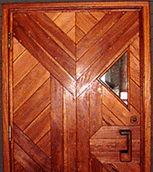Society for the Protection
Of New Hampshire Forest
Article By Amy L.
Web Site By Thomas W.
What can you do to
make your house more environmentally friendly? To answer this question
we decided to visit an award winning, environmentally friendly establishment,
the Society for the Protection of New Hampshire Forest (SPNHF). Upon
stepping on the grounds we instantly knew all our questions would be answered. The
SPNHF created several buildings, including an office building for two uses:
to carry on their non-profit work, and to educate others with their energy
saving and environmentally friendly designs.
grounds we instantly knew all our questions would be answered. The
SPNHF created several buildings, including an office building for two uses:
to carry on their non-profit work, and to educate others with their energy
saving and environmentally friendly designs.
Entering the main
building, you open a huge pine and cherry wooden door; once inside, you must
open another door before you enter the lobby. Having these two doors,
with a vestibule in between them is a heat saving feature. It prevents the  outside air from entering the building immediately.
outside air from entering the building immediately.
Once you enter the
lobby, the environmental consciousness of all the people is obvious.
The sun enters the lobby through 1500 square feet of glass. One important
aspect of the center is that the whole building is facing south with the glass
towards the sun. In an interview with Paul Leveille, the Property Manager,
he told us, "When building a new house, just by facing it towards the south
and concentrating your glass on that side, you could significantly reduce
your heating bill."
Not only does the
glass increase the amount of heat entering the building, but also the black
slate floor absorbs the energy and stores it during the day. At nighttime
the heat is slowly released. In other spots in the building, there
is carpeting made from recycled carpets.
The building is heated
by passive solar heating, meaning it takes in heat, stores it, and then releases
it slowly. There are other techniques they use to heat the buildings.
Thirty-four, 10-foot high transparent water tubes in the office areas also
heat the center. Each holds 132 gallons of water and the sun raises their
water temperature. 
Then the water reflects this into the office
buildings. The center also has a complex system to circulate hot air
trapped towards the ceiling and moving it below the building and back through
the floor panels.
Insulation is another
important technique the SPNHF uses to store heat and energy. Though when
the center was created the insulation was considered very "high tech", today
it is standard. The new building the center is currently working on
will be 11,000 square feet, and will be "super insulated." The center
is heated 80% by solar heating, and a wood stove and wood fired furnace provides
the other 20%.
The windows are kept
to a minimum on the north side, because it rarely sees the sun. The
earth is higher on this side with a low roof. This protects the north side
from the northwest winds.
Amazingly, they have
also devised a way to keep the center cool in the summer. The windows
are positioned so that the high summer sun does not hit them directly.
Also they have planted sugar maple trees to shade the center and vents in
the ceiling to release heat.
Why would the center
do all of this? What effect does it really have? The passive solar
heating reduces the need for burning fuels, which contribute to air pollution
and global warming. The center heats its own water with solar water
heaters. The hot water systems eliminate the need for propane or natural
gas. The solar panels on the top of the building offset about 5600
pounds of carbon dioxide in a year, thus eliminating the need to pay for
electricity from a utility that would be buying it from a coal fire plant.
The solar panels actually produce about 4000 kilowatts of electricity in
a year, saving them about $400. Compared to the $27,000 it cost for
the system, that is not saving a lot, but it is a lot when you consider the
environmental benefits.
After the tour, we
were very impressed with all the center is doing to help the environment.
Mr. Leveille offered these tips to the question, "What can we do in our own
house to help out a little?" Mr. Leveille gave us lots of good suggestions.
To paraphrase he told us, use your energy wisely. If you look at the
biggest environmental crises, the biggest of them, global warming, ozone
depletion, and acid rain, they all relate to our use of fossil fuels.
One thing we can do is live close to where we work or go to school.
Get some exercise and walk some places; this reduces the need for transportation
needing fossil fuels. Insulate your house, purchase energy efficient
appliances, and install energy efficient lights. Though this might cost
you a little more, the cost benefits will be returned to you in a few years
with the energy you save. Unplug your computers and TV’s. These
appliances are still running even when you turn them off, so that when you
turn them back on, they come on instantly. Andy Lovers from the Rocky
Mountain Institute said, "TV’s and VCRs and things like that should have
three switches, it should be on, off and really off."
Mr. Leveille gave
us more tips such as, use low VOC paints in your house that do not emit toxic
fumes. Don’t buy furniture made from medium density particleboard,
which is made with formaldehyde-based glue. Mr. Leveille
concludes this interview with these words: "Things you bring into your house
can have an environmental effect, positive or negative, on pretty much anything
you do." As we walked through the building one last time, we felt encouraged
to make our impact on the environment positive.
|